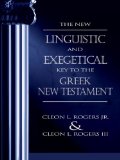The New Linguistic and Exegetical Key to the Greek New Testament. By Cleon L. Rogers, Jr. and Cleon L. Rogers, III. Grand Rapids: Zondervan Publishing House, 1998. 652 pp. Cloth, $39.99.
I have had the privilege of knowing both Cleon Rogers Jr., who was one of the my Greek professors in seminary, and Cleon Rogers, III, who was a contemporary of mine in seminary. Both father and son are very gracious men.
Their book is a very helpful tool for the person who has a working knowledge of Koine Greek. It is set up in New Testament order, beginning in Matthew 1:1 and ending in Revelation 22:21. By no means do they attempt to discuss every word in the Greek New Testament. Rather, they pick out one or more key words or phrases in each verse and comment on these. (Typically they select about four words or phrases per verse, but this is quite variable.)
As the title suggests, the authors provide linguistic and exegetical suggestions. For example, at 2 Cor 5:17 they comment on the word ktisis, saying, “creation. The one who is in Christ is part of the new creation” (p. 403).
For the pastor, there is much information here that provides colorful insight to sermons. For example, concerning gymnos in Jas 2:15 they state, “The term does not necessarily imply absolute nakedness; it was used of a person wearing only an undertunic and meant someone was poorly clad (Mayor)” (p. 558). Or, concerning the demons believing and trembling in Jas 2:19, “phrissousin…to bristle. It was used of the physical signs of terror, esp. of the hair standing on the end. The word often expresses only a high degree of awe or terror” (p. 558).
JOTGES readers will find their comments uneven on the gospel issue. For example, under 1 Cor 5:11 they begin well saying, “onomazomenos pres. pass. part.onomazo to name, to bear the name of” (p. 357). But then the very next words are, “His behavior shows that in truth he is not a Christian (Barrett). Concessive part., ‘although he is called’ (Kistemacher).” “To bear the name” is quite different than “although he is called.” The former suggests a genuine brother is in view. The latter leaves this in doubt.
This is also a helpful tool for a person who is translating the Greek NT, either a passage, or the whole NT.
I recommend this book for the serious student of NT Greek.
Robert N. Wilkin
Editor
Journal of the Grace Evangelical Society
Irving, TX


